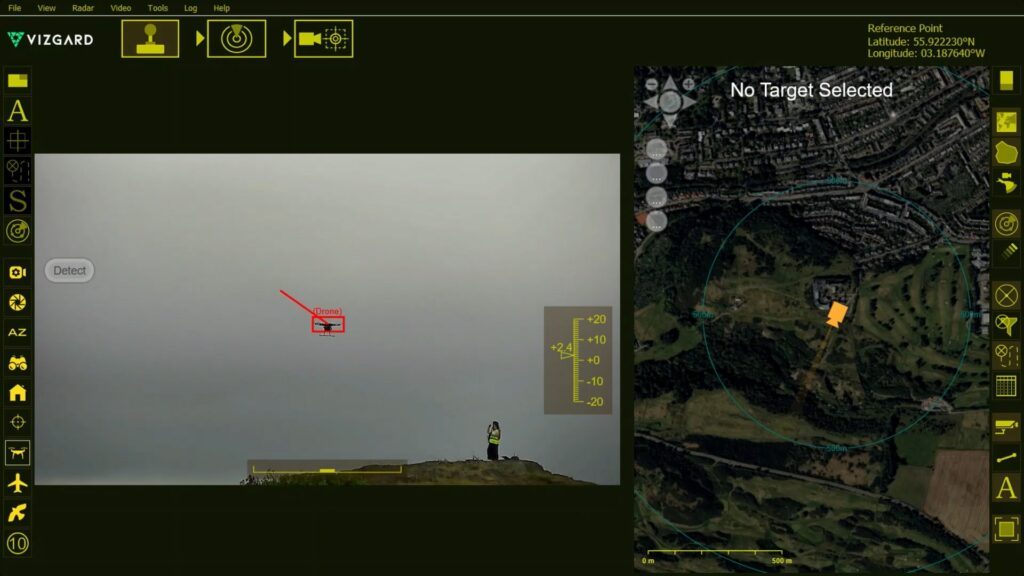Detect and Avoid (DAA) Technology is critical to advanced drone operations and flight beyond visual line of sight (BVLOS.) Now, a project demonstrates the use of computer vision DAA technology to detect other drones and aircraft in secured airspace.
Continue reading below, or listen:
Cambridge Pixel VSD Used in Police-Supported Project Testing Vision-Based Detect & Avoid for BVLOS Operations and Classification of Aerial Objects
by DRONELIFE Staff Writer Ian M. Crosby
Sensor processing and display solution developer Cambridge Pixel had joined a consortium with Vizgard and Gibson Robotics to combine the capabilities of each company for a final project demonstration earlier this month, at the Edinburgh Royal Observatory. The project, funded by a DASA Security Rapid Impact Open Call, with support from two UK police departments, set out to explore the use of vision-based 360° Detect and Avoid capabilities for BVLOS drone operations. The project utilized Vizgard’s onboard edge computer and an upgraded FortifAI computer vision server to simultaneously process six 4k video streams. An encrypted cellular connection was used to stream near-real-time classification of aerial objects, including other drones and their true bearings.
One of the major focuses of this project was showcasing how a vehicle-mounted PTZ (Pan-Tilt-Zoom) camera system could autonomously monitor the local airspace and sustain visual tracking of the police drone. Cambridge Pixel’s VSD display software was utilized with a local ADS-B receiver to display the position of transmitting aircraft on a bird’s eye map view. VSD’s advanced security monitoring with camera tracking and control made it an ideal solution for integration with Vizgard’s FortifAI, which employed multiple Deep Neural Networks to track the drone and monitor for non-transmitting aerial objects.
Cambridge Pixel recently upgraded VSD to support additional radars, devices and video tracking. Vizgard’s technology also grants automated long-range 360° visual detection along the ‘Skyway’ drone flight corridor, which will connect Reading, Coventry and Cambridge.
“Having had prior experience working with Cambridge Pixel on various C2 projects, I was already aware of the exceptional expert support we could anticipate for this project,” said Vizgard CEO Alex Kehoe. “With the integration of VSD and FortifAI, our capabilities have expanded, enabling us to cater to customers seeking to harness our AI for time-critical insight alongside their library of supported sensor technologies. This development not only broadens our service offerings but also creates exciting prospects for potential partnerships with other sensor providers, whether it be for C-UAS or more general security applications.”
Read more:
- FlytBase and Iris Automation Integrate Ground-Based Detect and Avoid with FlytNow Software for Automated, Remote Drone Ops
- Zipline Reveals Acoustic-Based Detect and Avoid Technology: Is This the Holy Grail for Drone Tech?
- CAL Analytics to Provide Detect and Avoid Service in NY Drone Corridor
- Vigilant Aerospace Detect and Avoid Drone Safety System Wins NASA’s Commercial Invention of the Year
Ian attended Dominican University of California, where he received a BA in English in 2019. With a lifelong passion for writing and storytelling and a keen interest in technology, he is now contributing to DroneLife as a staff writer.
Miriam McNabb is the Editor-in-Chief of DRONELIFE and CEO of JobForDrones, a professional drone services marketplace, and a fascinated observer of the emerging drone industry and the regulatory environment for drones. Miriam has penned over 3,000 articles focused on the commercial drone space and is an international speaker and recognized figure in the industry. Miriam has a degree from the University of Chicago and over 20 years of experience in high tech sales and marketing for new technologies.
For drone industry consulting or writing, Email Miriam.
TWITTER:@spaldingbarker
Subscribe to DroneLife here.
